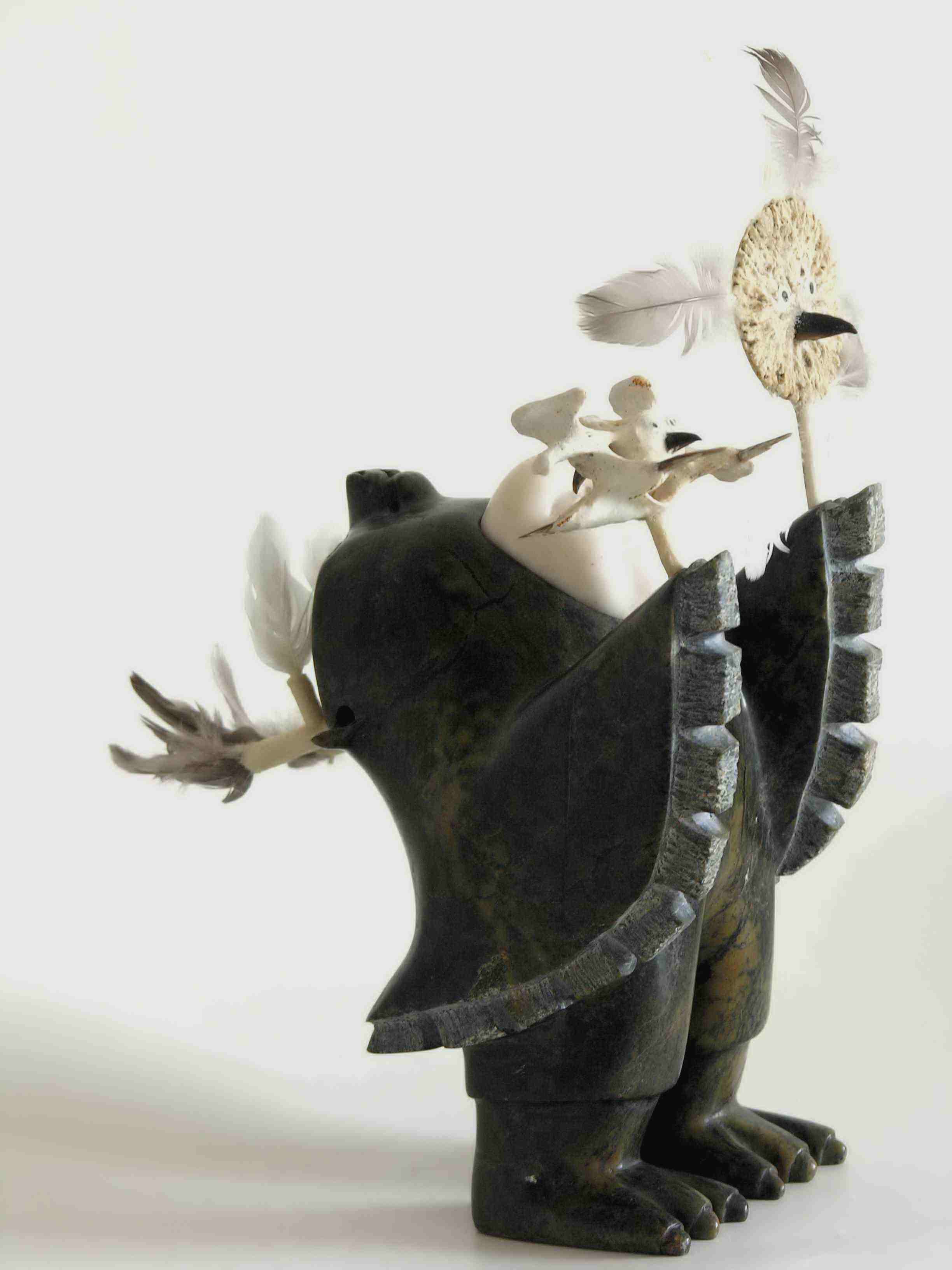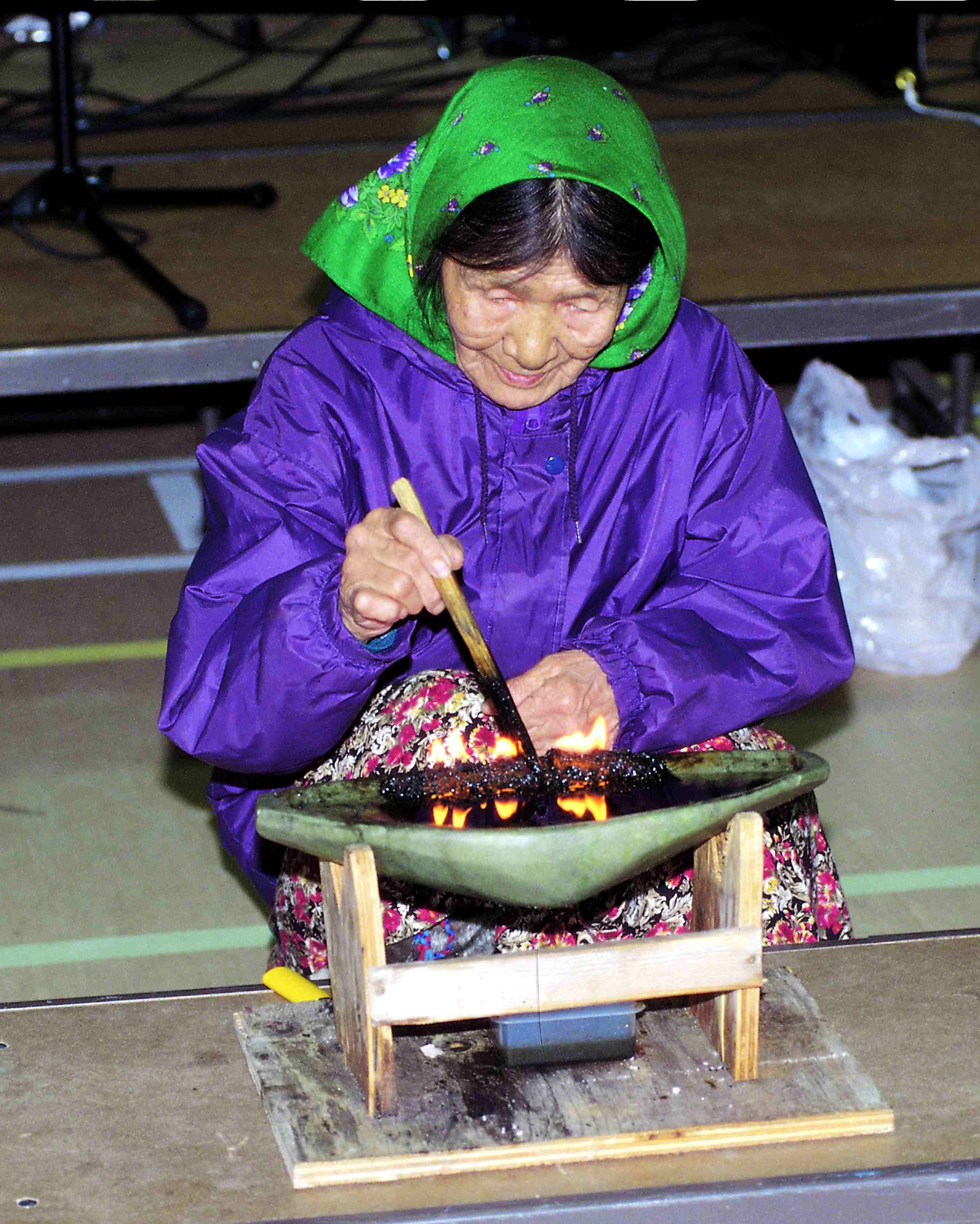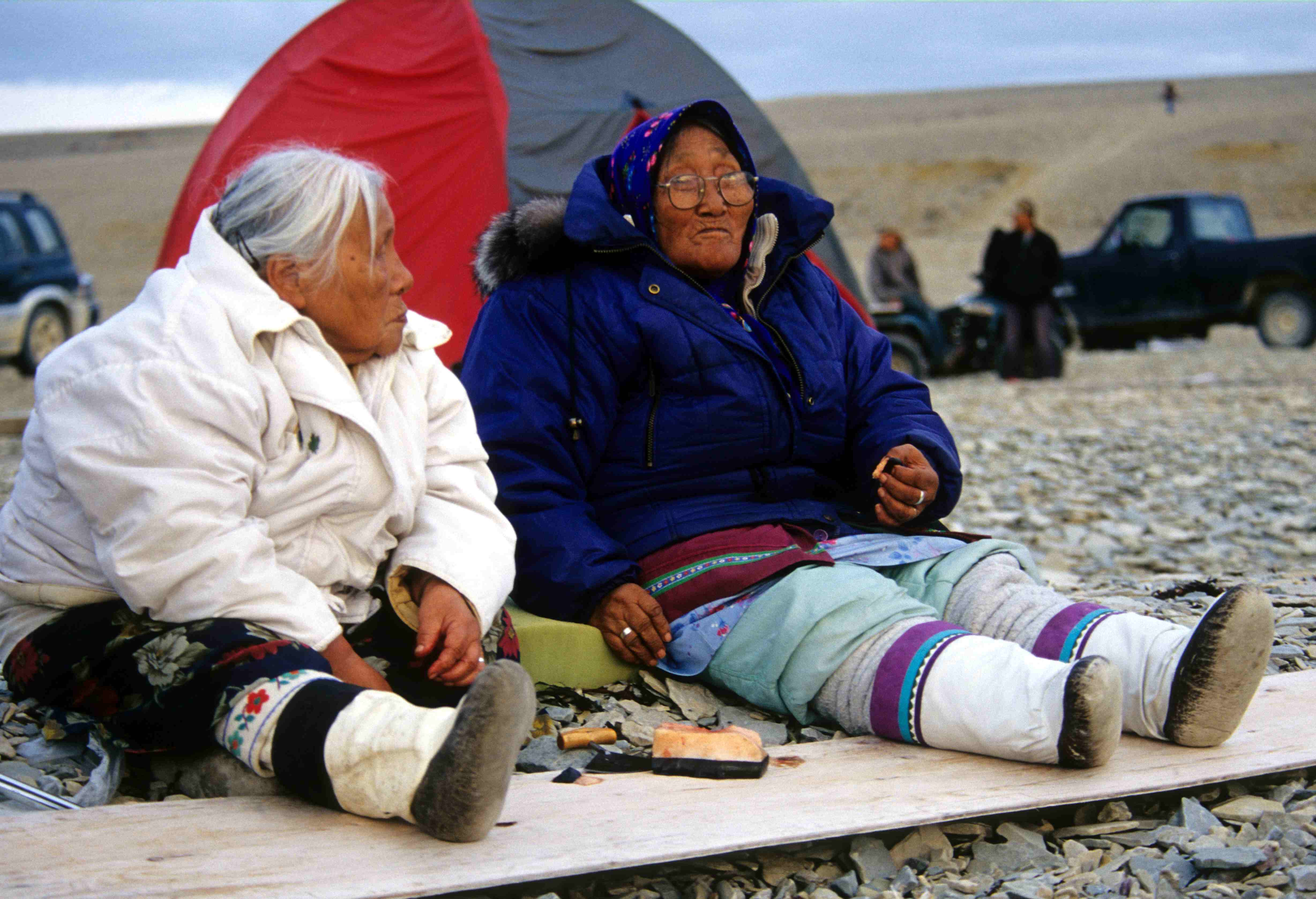|
Ada Eyetoaq
Ada Eyetoaq (alternatively: Eyetoaq Eyetoaq, Ada Eyetoaq, Kingilik Eyetoaq, Iyi'tuaq Eyetoaq, Eeyeetoaq Eyetoaq, Eyeetoaq Eyetoaq, Eeyeetowak Eyetoaq, Iyi'tag Eyetoaq, Eetoowa Eyetoaq, Eyittuak Eyetoaq, Eeyeeteetowak Eyetoaq, Iti'tuaq, Eeeyeetowa, Eda) was born in 1934 and died in 2014. She was a Baker Lake (Nunavut) Inuit who produced traditional Inuit art. She is primarily known for her miniature soapstone sculptures. Personal life Eyetoaq married James Kingilik, also a soapstone sculptor, in the early 1950s. They had seven children, five biological and two adopted. In 1968 they moved from their traditional Inuit camp at Beverly Lake to the Baker Lake settlement. After moving, they lived in a tent for two months due to a lack of housing. It was around this time that the couple began their work as sculptors in order to supplement their incomes. Art Besides her sculptures, Eyetoaq also created drawings, prints, wool duffels, and felt wall hangings. But, her carvings are wha ... [...More Info...] [...Related Items...] OR: [Wikipedia] [Google] [Baidu] |
Soapstone
Soapstone (also known as steatite or soaprock) is a talc-schist, which is a type of metamorphic rock. It is composed largely of the magnesium rich mineral talc. It is produced by dynamothermal metamorphism and metasomatism, which occur in the zones where tectonic plates are subducted, changing rocks by heat and pressure, with influx of fluids, but without melting. It has been a medium for carving for thousands of years. Terminology The definitions of the terms "steatite" and "soapstone" vary with the field of study. In geology, steatite is a rock that is to a very large extent composed of talc. The mining industry will define steatite as a high-purity talc rock that is suitable for manufacturing of, for example, insulators, the lesser grades of the mineral can be called simply "talc rock". Steatite can be used both in lumps ("block steatite", "lava steatite", "lava grade talc"), and in the ground form. While the geologists logically will use "steatite" to designate both forms, ... [...More Info...] [...Related Items...] OR: [Wikipedia] [Google] [Baidu] |
Baker Lake (Nunavut)
Baker Lake (Inuktitut: ; 'where the river widens') is a lake in the Kivalliq Region, Nunavut, Canada. It is fed by the Thelon River from the west and the Kazan River from the south. It outflows into Chesterfield Inlet. The lake is approximately in size. It has several named bays, and a few islands. In 1762 William Christopher reached Baker Lake via Chesterfield Inlet. The Inuit hamlet of Baker Lake, Nunavut, Baker Lake is at the west end of the lake near the mouth of the Thelon River. Although the Inuit had been in the area for some time, the first outside presence was the Royal North-West Mounted Police post at the east end of the lake in 1915. This was followed in 1916 by the Hudson's Bay Company post set up at the Kazan River delta until 1930 when it moved to its present location. Fauna The lake's area is home to Beverly and Qamanirjuaq Caribou herds, as well as other wildlife associated with northern Canada's Arctic. See also *List of lakes of Nunavut *List of lakes of Cana ... [...More Info...] [...Related Items...] OR: [Wikipedia] [Google] [Baidu] |
Inuit
Inuit (; iu, ᐃᓄᐃᑦ 'the people', singular: Inuk, , dual: Inuuk, ) are a group of culturally similar indigenous peoples inhabiting the Arctic and subarctic regions of Greenland, Labrador, Quebec, Nunavut, the Northwest Territories, and Alaska. Inuit languages are part of the Eskimo–Aleut languages, also known as Inuit-Yupik-Unangan, and also as Eskaleut. Inuit Sign Language is a critically endangered language isolate used in Nunavut. Inuit live throughout most of Northern Canada in the territory of Nunavut, Nunavik in the northern third of Quebec, Nunatsiavut and NunatuKavut in Labrador, and in various parts of the Northwest Territories, particularly around the Arctic Ocean, in the Inuvialuit Settlement Region. With the exception of NunatuKavut, these areas are known, primarily by Inuit Tapiriit Kanatami, as Inuit Nunangat. In Canada, sections 25 and 35 of the Constitution Act of 1982 classify Inuit as a distinctive group of Aboriginal Canadians wh ... [...More Info...] [...Related Items...] OR: [Wikipedia] [Google] [Baidu] |
Inuit Art
Inuit art, also known as Eskimo art, refers to artwork produced by Inuit, that is, the people of the Arctic previously known as Eskimos, a term that is now often considered offensive. Historically, their preferred medium was walrus ivory, but since the establishment of southern markets for Inuit art in 1945, prints and figurative works carved in relatively soft stone such as soapstone, serpentinite, or argillite have also become popular. The Winnipeg Art Gallery has the largest public collection of contemporary Inuit art in the world. In 2007, the Museum of Inuit Art opened in Toronto, but closed due to lack of resources in 2016. History Pre-Dorset and Dorset cultures Around 4000 BCE nomads known as the Pre-Dorset or the Arctic small tool tradition (ASTT) crossed over the Bering Strait from Siberia into Alaska, the Canadian Arctic, Greenland, and Labrador. Very little remains of them, and only a few preserved artifacts carved in ivory could be considered works of art. The ... [...More Info...] [...Related Items...] OR: [Wikipedia] [Google] [Baidu] |
Beverly Lake (Nunavut)
Beverly Lake ( Inuktitut: }, "it has driftwood") is a lake in the Kivalliq Region, Nunavut, Canada. It is located north of the Arctic tree line about northwest of Baker Lake, Nunavut. The western half of the lake is within Thelon Wildlife Sanctuary. The Thelon River, at the confluence with the Dubawnt River, empties into the lake's southwestern bank. The Kazan River empties into the Thelon River at Beverly Lake's southeastern bank, between Beverly and Aberdeen Lakes. A delta occurs on the Beverly Lake's southern edge, which includes the Isarurjuaq Peninsula. Geography Most of the area is underlain by Dubawnt sandstone. Flora The vegetation is low Arctic. Fauna The lake boasts boreal and arctic fish species, uncommon to the area. Approximately 10,000 moulting Canada Geese use the Beverly/Aberdeen Lake area, including Lesser Snow geese colonies on islands within Beverly Lake, making it a key migratory bird terrestrial habitat site, and the largest concentration of the large r ... [...More Info...] [...Related Items...] OR: [Wikipedia] [Google] [Baidu] |
Baker Lake, Nunavut
Baker Lake (Inuktitut syllabics: ᖃᒪᓂᑦᑐᐊᖅ 'big lake joined by a river at both ends', Inuktitut: ''Qamani'tuaq'' 'where the river widens') is a hamlet in the Kivalliq Region, in Nunavut on mainland Canada. Located inland from Hudson Bay, it is near the nation's geographical centre, and is notable for being Nunavut's sole inland community. The hamlet is located at the mouth of the Thelon River on the shore of Baker Lake. The community was given its English name in 1761 from Captain William Christopher who named it after Sir William Baker, the 11th Governor of the Hudson's Bay Company. History In 1916, the Hudson's Bay Company established a trading post at Baker Lake, followed by Anglican missionaries in 1927. The Royal Canadian Mounted Police had been in the area for fifteen years before establishing a post at Baker Lake in 1930. In 1946 the population was 32, of which 25 were Inuit. A small hospital was built in 1957, followed by a regional school the next year. ... [...More Info...] [...Related Items...] OR: [Wikipedia] [Google] [Baidu] |
Inuit Culture
The Inuit are an indigenous people of the Arctic and subarctic regions of North America (parts of Alaska, Canada, and Greenland). The ancestors of the present-day Inuit are culturally related to Iñupiat (northern Alaska), and Yupik (Siberia and western Alaska), and the Aleut who live in the Aleutian Islands of Siberia and Alaska. The term culture of the Inuit, therefore, refers primarily to these areas; however, parallels to other Eskimo groups can also be drawn. The word " Eskimo" has been used to encompass the Inuit and Yupik, and other indigenous Alaskan and Siberian peoples, but this usage is in decline. Various groups of Inuit in Canada live throughout the Inuvialuit Settlement Region of the Northwest Territories, the territory of Nunavut, Nunavik in northern Quebec and Nunatsiavut in Labrador and the unrecognised area known as NunatuKavut. With the exception of NunatuKavut these areas are sometimes known as Inuit Nunangat. The traditional lifestyle of the Inuit i ... [...More Info...] [...Related Items...] OR: [Wikipedia] [Google] [Baidu] |
Inuit Cuisine
Historically Inuit cuisine, which is taken here to include Greenlandic cuisine, Yup'ik cuisine and Aleut cuisine, consisted of a diet of animal source foods that were fished, hunted, and gathered locally. In the 20th century the Inuit diet began to change and by the 21st century the diet was closer to a Western diet. After hunting, they often honour the animals' spirit by singing songs and performing rituals. Although traditional or country foods still play an important role in the identity of Inuit, much food is purchased from the store, which has led to health problems and food insecurity. According to Edmund Searles in his article "Food and the Making of Modern Inuit Identities", they consume this type of diet because a mostly meat diet is "effective in keeping the body warm, making the body strong, keeping the body fit, and even making that body healthy". Food sources * Hunted meats: ** Sea mammals such as walrus, seal, and whale. Whale meat generally comes from the narwhal, ... [...More Info...] [...Related Items...] OR: [Wikipedia] [Google] [Baidu] |
Amon Carter Museum Of American Art
Amon may refer to: Mythology * Amun, an Ancient Egyptian deity, also known as Amon and Amon-Ra * Aamon, a Goetic demon People Momonym * Amon of Judah ( 664– 640 BC), king of Judah Given name * Amon G. Carter (1879–1955), American publisher and art collector * Amon Göth (1908–1946), Austrian concentration camp commandant in the Nazi SS during World War II * Amon Saba Saakana (formerly Sebastian Clarke), British-Trinidadian writer, broadcaster and publisher * Amon-Ra St. Brown (born 1999), American football wide receiver * Amon Tobin (born 1972), Brazilian IDM producer Surname * Angelika Amon (1967–2020), Austrian-American molecular biologist * Chris Amon (1943–2016), New Zealand motor racing driver * Cristiano Amon (born 1970), Brazilian-American manager * Cristina Amon, Uruguyan-born American scientist and academic * Johann Andreas Amon (1763–1825), German composer * Morissette (singer) (born 1996), Filipina singer-songwriter Music * Amon, original na ... [...More Info...] [...Related Items...] OR: [Wikipedia] [Google] [Baidu] |
Canadian Museum Of History
The Canadian Museum of History (french: Musée canadien de l’histoire) is a national museum on anthropology, Canadian history, cultural studies, and ethnology in Gatineau, Quebec, Canada. The purpose of the museum is to promote the heritage of Canada, as well as support related research. The museum is based in a designed by Douglas Cardinal. The museum originated from a museum established by the Geological Survey of Canada in 1856, which later expanded to include an anthropology division in 1910. In 1927, the institution was renamed the National Museum of Canada. The national museum was later split into several separate institutions in 1968, with the anthropology and human history departments forming the National Museum of Man. The museum relocated to its present location in Gatineau in 1989 and adopted the name Canadian Museum of Civilization the following year. In 2013, the museum adopted its current name, the Canadian Museum of History, and saw its mandate modified so further ... [...More Info...] [...Related Items...] OR: [Wikipedia] [Google] [Baidu] |
Art Gallery Of Guelph
The Art Gallery of Guelph (AGG), formerly the Macdonald Stewart Art Centre, is a public gallery and adjoining sculpture park in Guelph, Ontario. The AGG has a collection of over 9,000 works and focusses on research, publishing, educational programs, and touring exhibitions. History Today, the AGG is a non-profit charitable organization with three sponsors: the University of Guelph, the City of Guelph, and the Upper Grand District School Board. As the principal public art gallery serving Guelph and the surrounding region, the Art Gallery of Guelph was founded as a new cultural institution to benefit the broad community. MSAC was established in 1978 through a provincial act as a non-profit charitable organization. When the gallery formally opened as a public art gallery on November 7, 1980, the University of Guelph curator, Judith Nasby, was appointed director and curator of the MSAC. Architect Raymond Moriyama renovated the historic 1904 school building to create a public art ga ... [...More Info...] [...Related Items...] OR: [Wikipedia] [Google] [Baidu] |
Montreal Museum Of Fine Arts
The Montreal Museum of Fine Arts (MMFA; french: Musée des beaux-arts de Montréal, MBAM) is an art museum in Montreal, Quebec, Canada. It is the largest art museum in Canada by gallery space. The museum is located on the historic Golden Square Mile stretch of Sherbrooke Street. The MMFA is spread across five pavilions, and occupies a total floor area of , 13,000 () of which are exhibition space. With the 2016 inauguration of the Michal and Renata Hornstein Pavilion for Peace, the museum campus was expected to become the eighteenth largest art museum in North America. The permanent collection included approximately 44,000 works in 2013. The original "reading room" of the Art Association of Montreal was the precursor of the museum's current library, the oldest art library in Canada.MMFA Library The Montreal Museum of Fine Arts is a member of ... [...More Info...] [...Related Items...] OR: [Wikipedia] [Google] [Baidu] |
_-_several_colored_samples.jpg)



.jpg)
